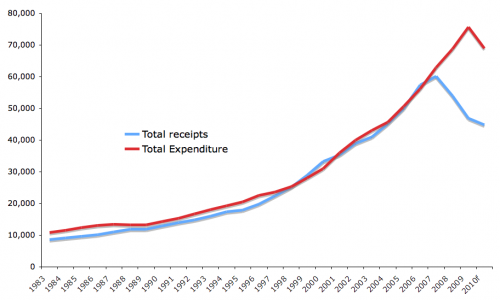Jan
29
What Can We Learn from Ireland’s Meltdown?
The “Celtic Tiger”.
Until recently, the Emerald Isle was enjoying tremendous economic success, due to dramatic fiscal policy reform. First, they put a cap on government spending in the late 1980s, then reduced tax rates during the 1990s. Hugely important was the reduction in the corporate tax rate from 50 percent down to 12.5 percent. This resulted in bringing in tons of new investment, which led to more revenue from corporate taxes than before the reduction. Our own Newt Gingrich has been touting Ireland as a model in this respect, and for precisely this reason, urging U.S. tax reformers to support a 12.5% corporate tax.
Unfortunately, as Daniel J. Mitchell of the Cato Institute points out,
“[G]ood corporate tax policy does not guarantee good economic performance if the government is making a lot of mistakes in other areas. This is an apt description of what happened to Ireland.”
In other words,… Low Corporate Tax Rates Are Good, but They Don’t Guarantee Economic Success if other Policies Are Bad.
This is one of five lessons that Mitchell feels the U.S. can & should learn from Ireland’s current financial woes. So, what else has gone wrong over there and what can we learn from it? I’ll try to give you the short version….
Excessive Government Spending Is a Path to Fiscal Ruin: Starting in the 1980s, Ireland’s federal revenues were climbing, and life was good. As the lower tax rates went into effect in the 1990s, those revenues really took off! Of course, the government spent it as fast as it came in. But, the people hardly noticed. In fact, between 1983 & 2000, spending actually went down as a share of GDP, ‘cuz private sector growth continued to outpace the public sector. Then, the politicians decided they could kick spending up a notch or two to roughly match the private sector growth rate. (Free money, right? Why not spend it?) When economic troubles (see below) really started to be felt and revenue began a nosedive (~2007), the politicians were stuck in spend-mode and “forgot” to notice. It took a couple years before they started choking back on spending, but the damage was done….
“Government spending diverts resources from the productive sector of the economy. This is now painfully apparent since there no longer is a revenue windfall to mask the damage.”
American government spending started to swell under G.W. Bush (some legitimate, some questionable), then accelerated obscenely under the current Obama administration (with Democrat majorities in both houses of Congress). The U.S.’s financial bailout wasn’t as big as Ireland’s (as % of GDP), but we’ve got a bigger crisis-in-the-making. When baby-boomers start trying to collect on Medicare, Medicaid, and Social Security,… look out! Can we institute realistic reforms in time?
Bailouts Don’t Work: The Irish government bailed out its three big banks, but it made the (further) mistake of bailing out their creditors, too. (TARP, anyone?) So, not only was the bank bailout much more expensive than it “needed” to be, it also encouraged irresponsible investment by those who figured they could take bigger risks, as long as the government would come to the rescue. The additional federal debt destabilized Ireland’s finances, leading to… a national bailout by the European Union (EU) and the International Monetary Fund (IMF). Everybody pays!
Obama et al. have already provided subsidies to some states in financial crises via stimulus funds. As Mitchell puts it, “This encouraged states to dig themselves deeper in a fiscal hole.” This behavior has got to stop!
Artificially Low Interest Rates Encourage Bubbles: As soon as Ireland replaced their own currency with the euro in 1999, they effectively shot themselves in the foot. They then became subject to interest rates based on all the floundering economies of the European Union. If Ireland’s currency had still been independent, the economic boom and resultant demand by investors for more credit would likely have driven up interest rates. Instead, interest rates remained artificially low, which led to a bubble. (Sound familiar?)
“Easy money is a recipe for inflation and/or bubbles. Simply stated, excess money has to go someplace and the long-run results are never pleasant.”
Housing Subsidies Reduce Prosperity: To make matters worse, Irish politicians made real estate a highly-favored form of investment by giving out housing subsidies. This combined with the artificially low interest rates to produce a huge wave of investments in real estate that weren’t what they were cracked up to be. (Again, methinks I’ve heard this tune before.)
I think Mitchell makes some very valid points. I just hope people in the right places — state and federal governments, influential individuals and agencies — take heed and don’t let the hard lessons of Ireland (and others) be wasted. The U.S. does not have to go any further down this road!

















